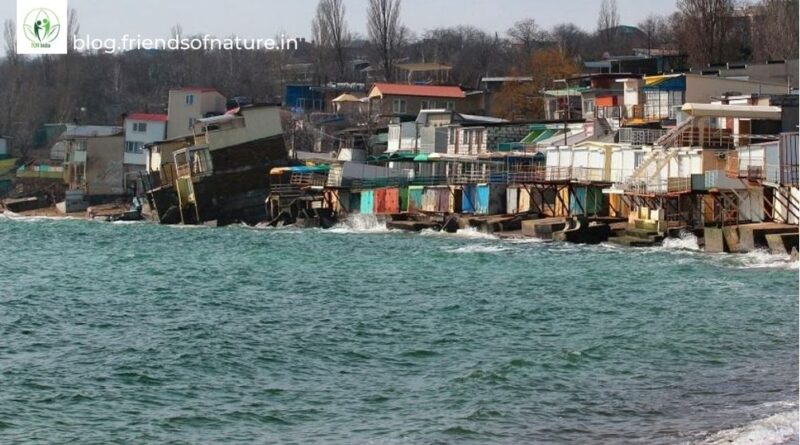Climate crisis: Coastal areas may become unliveable by 2100
People living in and near the coastal areas in India may be compelled to stay indoors during working hours for more than half of 2100. Severe heat conditions — and not the novel coronavirus disease (COVID-19) pandemic — would be driving people to do so, a recent report by Climate Trends has flagged.
Millions in India are currently reeling under a severe heat wave. Scientists have warned that the rising climate crisis will make the situation more unbearable in the coming years.
The report said most parts of India experience 12-66 days of potentially deadly heat and humidity combinations in a year — expressed by ‘wet bulb temperature’. It is an index that measures the impact of heat and humidity on the human body.
A temperature increase of 4.3 degrees Celsius by 2100 relative to pre-industrial temperatures may happen under RCP (representative concentration pathway) 8.5 scenario, the report pointed out. The wet bulb temperature will cross the deadly threshold for six months or more by another nine decades, it said.
Heat and humid hotspots to suffer most
Most of India experiences 12-66 days of a combination of potentially deadly heat and humidity with hotspots along the east coast.
The report predicted that under RCP 8.5 scenario such days may increase to:
- 221 from 124 in Kolkata
- 253 from 171 in Sundarbans
- 282 from 178 in Cuttack
- 285 from 173 in Brahmapur
- 365 from 113 in Thiruvananthapuram
- 309 from 140 in Chennai
- 261 from 47 in Mumbai
- 131 from 63 in New Delhi
“The west coast will be increasingly affected with around 269 days of wet bulb temperature days in Goa (up from 35 currently); 362 days in Kochi (up from 98); and around 349 days in Mangalore (up from 72 currently),” the report said.

The report warned of a substantial worsening of situation even by 2050. Kolkata may experience 176 deadly heat-humid days; the Sundarbans 215; Cuttack 226; Brahmapur 233; Thiruvananthapuram 314; Chennai 229; Mumbai 171; and New Delhi 99.
Under RCP 2.6 — a very stringent pathway that requires carbon dioxide emissions to start declining by 2020 and go to zero by 2100 — the number of critical heat-humid days will be 157 in Kolkata; 193 in the Sundarbans; 216 in Cuttack; 218 in Brahmapur; 240 in Thiruvananthapuram; 179 in Chennai; 112 in Mumbai; 81 in New Delhi; 94 in Goa; 163 in Mangalore; and 206 in Kochi by 2100.
“Air can hold more moisture with more heat, and the combined impact of heat and humidity becomes critical. With more warming under climate change impact, the combined impact of heat and humidity is set to rise,” said Roxy Mathew Koll, a climate scientist from the Indian Institute of Tropical Meteorology, Pune.
Koll pointed out that so far, neither Intergovernmental Panel on Climate Change nor India’s own official assessment has considered the combined impact of weather-related events and suggested that such studies and assessment needed to be undertaken at the earliest.

Heat humidity combination may affect health, productivity
There are five physiological mechanisms, according to the report, which are triggered by heat exposure: Ischemia (reduced and restricted blood flow), heat cytotoxicity (cell death), inflammatory response (swelling), disseminated intravascular coagulation (abnormal blood clotting), and rhabdomyolysis (breakdown of muscle fibres).
These mechanisms affect seven vital organs: Brain, heart, intestines, kidneys, liver, lungs and pancreas. “There are 27 lethal combinations of these mechanisms and organs that have been shown to be caused by heat,” the report said.
A recent paper authored by top meteorologists in the country, including M Rajeevan, secretary in the Union ministry of earth sciences, and published in journal Weather and Climate Extremes claimed that heat waves caused 17,362 deaths during the last five decades. These accounted for 12 per cent of total deaths due to extreme weather events.
According to the study, India experienced 73 heat wave spells in 2019 against an average of 17 as measured during 1986-2016.
It also warned that most of India is presently facing a ‘high’ risk to workability during the hottest months with wet bulb temperature ranging from 30-33°C. It estimated that India currently loses an estimated 21 per cent of effective outdoor working hours due to extreme heat and humidity.
A McKinsey report, published 2020, stated that under the worst possible climate impact scenario of RCP 8.5, the loss of outdoor working hours may increase to 24 per cent by 2030 and 30 per cent by 2050.
This was originally published by downtoearth.org.in




